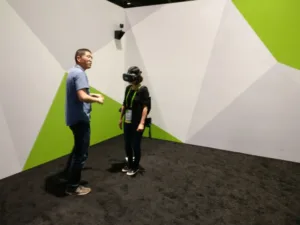A group of researchers from Stony Brook University in New York, in collaboration with Nvidia and Adobe, have created a new eye-tracking technique designed to make virtual spaces feel more open and free.
The technique, called dynamic saccadic redirection, tracks saccades — rapid, unconscious eye movements made every few seconds that are suppressed by the brain and therefore imperceptible to humans.
It influences user movements by increasing the speed of movement in the virtual world while saccades are occurring, and is able to suppress the distortion and motion sickness that would normally be associated with such an effect.
With dynamic saccadic redirection, using HTC Vive and SensoMotoric Instruments’ gaze-tracking technology, the team are reported to have turned a 1m² room into an apparent 2m² space. Take a look at the technique in action in this video uploaded by Road to VR.

